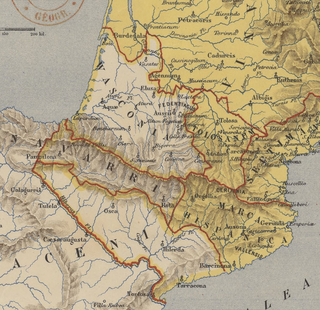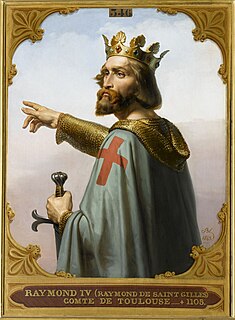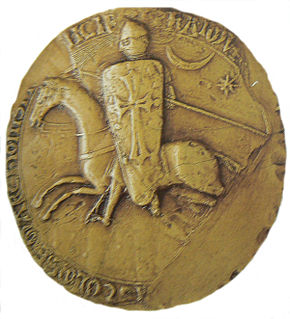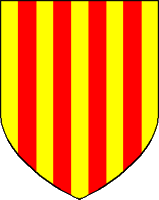Related Research Articles

Septimania is a historical region in modern-day southern France. It referred to the western part of the Roman province of Gallia Narbonensis that passed to the control of the Visigoths in 462, when Septimania was ceded to their king, Theodoric II. Under the Visigoths it was known as simply Gallia or Narbonensis. Septimania territory roughly corresponds with the former administrative region of Languedoc-Roussillon that merged into the new administrative region of Occitanie. Septimania was conquered by the Muslims and was part of the Al-Andalus. It passed briefly to the Emirate of Córdoba, which had been expanding from the south during the eighth century before its subsequent conquest by the Franks, who by the end of the ninth century termed it Gothia or the Gothic March.

Villeneuve-lès-Maguelone is a commune in the Hérault department in the Occitanie region in southern France.

The Hispanic Marches, also known as the March of Barcelona, was a military buffer zone beyond the former province of Septimania, established by Charlemagne in 795 as a defensive barrier between the Umayyad Moors of Al-Andalus and the Frankish Carolingian Empire.

The Count of Toulouse was the ruler of Toulouse during the 8th to 13th centuries. Originating as vassals of the Frankish kings, the hereditary counts ruled the city of Toulouse and its surrounding county from the late 9th century until 1270. The counts and other family members were also at various times counts of Quercy, Rouergue, Albi, and Nîmes, and sometimes margraves of Septimania and Provence. Count Raymond IV founded the Crusader state of Tripoli, and his descendants were also counts there. They reached the zenith of their power during the 11th and 12th centuries, but after the Albigensian Crusade the county fell to the kingdom of France, nominally in 1229 and de facto in 1271.
Bernardof Septimania (795–844), son of William of Gellone, was the Frankish Duke of Septimania and Count of Barcelona from 826 to 832 and again from 835 to his execution. He was also count of Carcassonne from 837. He was appointed to succeed his fellow Frank Rampon. During his career, he was one of the closest counsellors of the Emperor Louis the Pious, a leading proponent of the war against the Moors, and opponent of the interests of the local Visigothic nobility.
Berengar, called the Wise, was the count of Toulouse (814–835) and duke of Septimania (832–835). He held the County of Barcelona concomitantly with Septimania.

Raymond VI was Count of Toulouse and Marquis of Provence from 1194 to 1222. He was also Count of Melgueil from 1173 to 1190.
Sunifred was the Count of Barcelona as well as many other Catalan and Septimanian counties; including Ausona, Besalú, Girona, Narbonne, Agde, Béziers, Lodève, Melgueil, Cerdanya, Urgell, Conflent, and Nîmes; from 834 to 848 and from 844 to 848 (others).
Bernard II was the Count of Barcelona, Girona and Margrave of Gothia and Septimania from 865 to 878.
Berengar Raymond (1115–1144) was the count of Provence (1131–1144). He was the younger son of Raymond Berengar III, Count of Barcelona, and Douce I, Countess of Provence. While his older brother Raymond Berengar received Barcelona, he received Provence.

This is a list of the counts of Roussillon.
The viscount of Narbonne was the secular ruler of Narbonne in the Middle Ages. Narbonne had been the capital of the Visigoth province of Septimania, until the 8th century, after which it became the Carolingian Viscounty of Narbonne. Narbonne was nominally subject to the Carolingian counts of Toulouse but was usually governed autonomously. The city was a major port on the Mediterranean Sea. In the 12th century, Ermengarde of Narbonne presided over one of the cultural centers where the spirit of courtly love was developed. In the 15th century Narbonne passed to the County of Foix and in 1507 to the royal domain of France.
The County of Carcassonne was a medieval fiefdom controlling the city of Carcassonne, France and its environs. It was often united with the County of Razès.

Douce II was Countess of Provence and Viscountess of Gévaudan and Carlat for a few months in 1166, as well as Countess of Melgueil for some time in 1172. She was a member of the House of Barcelona, a dynasty of Catalan origin that acquired the County of Provence through the marriage of Douce I to Ramon Berenguer III, Count of Barcelona.
William of Septimania was the son of Bernard and Dhuoda. He was the count of Toulouse from 844 and count of Barcelona from 848.
William VII of Montpellier was the eldest son of William VI and of his wife Sibylle.
Ermessende of Pelet was the last heiress of the County of Melgueil, in southern France, and the last countess before it was joined with the County of Toulouse.
Fredelo, Fridolo, or Frigidolo was the first Count of Toulouse (844–852) of the dynasty of Rouergue.
The title Prince of Gothia or Prince of the Goths was a title of nobility, sometimes assumed by its holder as a sign of supremacy in the region of Gothia and sometimes bestowed by the sovereign of West Francia to the principal nobleman in the south of the realm, in the ninth and tenth centuries. Sometimes hereditary and sometimes not, the title has been rendered in English as Dukeof Septimania or Dukeof Gothia. A similar or the same "office" was often held with the title comes marcæ Hispanicæ: "Count of the Spanish March." The title was also a chronicler's device and, as presented in some chronicles, may never have been used in any official capacity.
Bernard V, son of Raymond Pilet d’Alès and his wife Mabel, of an unknown family. Count of Meigueil, by right of his wife. Seigneur of Alès. Bernard became Count of Meigueil upon his marriage to Beatrix de Melgueil, in 1146. One source claims Bernard was in the First Crusade, but there is no evidence that this was the case.
References
- Devic, Claude, and Vaissète, Joseph, Histoire générale de Languedoc : Volume I, Toulouse, édition Privat, 1872
- Emmerson, Richard K., Key Figures in Medieval Europe: An Encyclopedia. Routledge Publishing, New York, 2013
- Nobility of Toulouse: Chapter 11. Comtes de Melgueil at the Medieval Lands Project.